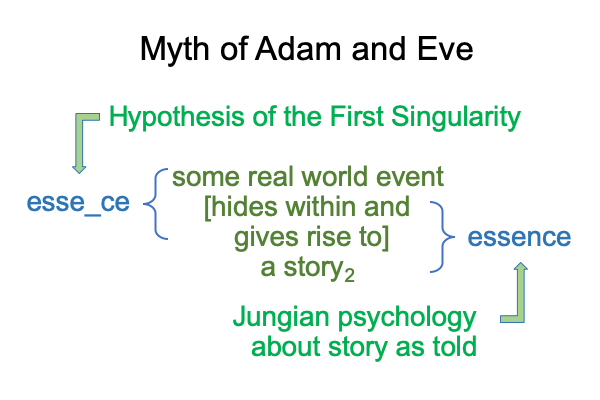0026 Now, I want to offer an example. This example may take Father Longenecker by surprise. It is the story of Adam and Eve found in the early chapters of Genesis.
Many argue that the temptation of Eve is pure fantasy. It is pure essence. There is no esse_ce. Really, a talking serpent?
0027 Longnecker may speak of the essence, using Jungian psychology.
I will offer a picture of the esse_ce, using the evolution of talk, as opposed to the evolution of language.

0028 Two works shed light upon the esse_ce of this myth. One is a scientific proposal, The First Singularity and Its Fairy Tale Trace. The other is the dramatic fiction, An Archaeology of the Fall. The evolutionary backdrop for both is found in The Human Niche.
0029 What is the evolution of talk, in a nutshell?
Starting with the adaptation of walking, characteristic the genus, Australopithecus, the foot is enslaved and the hand is freed. The hand is free to gesture. Why gesture? Manual-brachial gestures convey intentions during team activities. Why engage in team activities? That is how a band of walking apes survives.
Homo habilis and erectus adapt to the opportiunity that manual-brachial gestures offer. Gestures convey intent (message), content (meaning) and role (presence) during team activities. The semiotic qualities of hand talk are iconic (images) and indexal (indicators). So, a referent defines the message, meaning and presence of its word-gesture.
Hand talk is crucial for team activities, such as gathering seasonal vegetables and hunting or scavenging game.
0030 On top of that, word-gestures should differ from one another, fitting Ferdinand de Saussure’s definition of languageas two related systems of differences, parole (manual-brachial gesture) and langue (particular sets of messages, meaning and presences).
0031 The domestication of fire allows hand talk to become a team activity in itself. Hand talk expands from team-activities to something more general (that is, conversation). A full fledged grammar develops, all in the milieu of hand talk.
The generalization of talk is very successful, expanding brain volume and group size.
0032 Humans evolve in social circles of increasing size. Larger circles have different dynamics than smaller circles. Bands are permanent. Bands gather in community. Communities are semi-permanent. Communities gather into mega-bands. Mega-bands are seasonal. Mega-bands gather into tribes. Tribes meet occasionally.
Adaptation to gatherings of the larger groups includes the use of the voice for social synchronization. When the tribe gathers, time is limited. Everyone must quickly get in sync. The voice comes under neural control for singing. The Neanderthal and the Denisovan most likely practice lingusitic hand talk and sing.
0033 With the speciation of anatomically modern humans, around 200,000 years ago, the voice is exapted for language. The voice joins hand talk. From the very start, Homo sapiens practices hand-speech talk.
Hand-speech talk lasts for hundreds of thousands of years, until…
Something weird happens.
0034 Slightly before 7800 years ago, one culture drops the hand talk component of hand-speech talk. The Ubaid of southern Mesopotamia forms when rising ocean waters fill the formerly dry-lands of the Persian Gulf, pushing a river and coast dwelling mesolithic culture into the same territory as a dry-land stock-breeding culture. The cultures meld, despite thier vastly different traditions. Their way of talking breaks down into pidgin. The resulting creole is unrelated to any family of languages. This creole is the Sumerian language. Sumerian is a linguistic isolate.
0035 The Ubaid culture is the first speech-alone talking culture. Speech-alone talk has very different semiotic qualities than hand-speech talk. Speech-alone talk cannot image or point to anything. So, the referent cannot define the word. Instead, message, meaning and presence is projected into the mind, as if there is a referent that is pictured or pointed to.
0036 Does that sound like the snake-like serpent talking to Eve?
The snake says speech-alone words and Eve projects message, meaning and presence into the forbidden fruit.
This is what we do in our current Lebenswelt of speech-alone talk. Such projection is not possible in the Lebenswelt that we evolved in, of hand and hand-speech talk.
0037 Needless to say, this shift in the semiotic qualities of talk potentiates the formation of unconstrained social complexity, including civilization. Speech-alone talk spreads to the far corners of the Earth, on the wings of power and wealth, the fruits of unconstraind social and labor specialization.
0038 Yes, the key to the talking serpent is this: The serpent has no limbs. It cannot engage in hand talk. Therefore, it presents an image of the actualization of speech-alone talk.
How creepy is that?
The talking serpent is more real that anyone imagined.
The talking serpent is a clue to the esse_ce of the story of Adam and Eve.
0039 Fr. Dwight Longenecker is onto something. The stories of the Bible have esse_ce and essence.
Longenecker’s work on the infant narratives stands at the threshold of the use of both Jungian psychology and independent inquiry to address revelation. Real world events, like grains of sand, hide within Biblical stories, embodying pearls of revelation. In myth, esse_ce meets essence.
